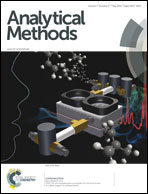Direct and quantitative detection of dicyandiamide (DCD) in milk using surface-enhanced Raman spectroscopy†
Abstract
Dicyandiamide (DCD) is a contaminant found in New Zealand's milk supply, which needs to be examined for security. In this study, the feasibility of using a SERS technique to detect DCD in milk was evaluated. Assignments of the DCD vibrational spectra have been conducted by DFT calculations. The influences of different aggregating agents and pH have been investigated in terms of their efficiency for detecting DCD. Two detection modes were established for detecting DCD in an aqueous solution. Among the three ions, SO42− provides the best performance in both acidic and alkaline conditions, and the limit of detection in alkaline conditions (with an enhancement factor of 2.88 × 105) is lower than that under acidic conditions. For real milk samples, based on a particular order of agent addition, DCD can be quantitatively detected without any sample pretreatment through an internal standard method. The linear coefficient is 0.99747 at a concentration range from 1 × 10−4 to 1 × 10−3 g mL−1. By exploiting the multi-component detection ability and high sensitivity of SERS, our scheme has advantages such as simplicity, reduced time and good accuracy over other methods, which shows a great promise for the on-site screening of DCD in milk products.


 Please wait while we load your content...
Please wait while we load your content...